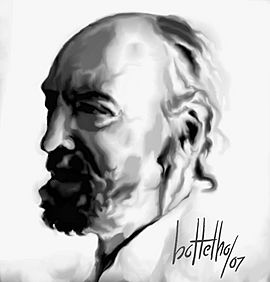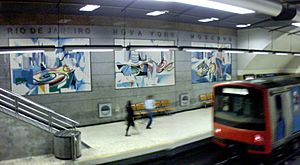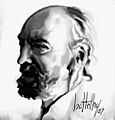Nadir Afonso facts for kids
Quick facts for kids
Nadir Afonso
|
|
|---|---|

2007 digital portrait of Afonso
|
|
| Born |
Nadir Afonso Rodrigues
4 December 1920 Chaves, Portugal
|
| Died | 11 December 2013 (aged 93) |
| Nationality | Portuguese |
| Education | Escola Superior de Belas Artes do Porto, Oporto École Nationale Supérieure des Beaux-Arts, Paris |
| Known for | Painting, Architecture |
|
Notable work
|
Cities series |
| Movement | Geometric abstract art (also Kinetic art, Op art) |
| Awards | Order of St. James of the Sword, Portuguese Academy of Fine Arts |
| Patron(s) | Portinari, Vasarely, Léger, Auguste Herbin, André Bloc, Le Corbusier |
Nadir Afonso (born December 4, 1920 – died December 11, 2013) was a famous Portuguese painter. He was known for his unique style called geometric abstract art. This means his paintings used shapes and lines instead of realistic pictures.
Nadir Afonso first trained as an architect and even worked with famous architects like Le Corbusier. But he loved painting more. He later studied art in Paris and became a leader in Kinetic art. This art style often uses movement or gives the feeling of movement. He worked with other important artists like Victor Vasarely.
Nadir Afonso believed that art followed rules, like a science. He thought art was about observing and arranging shapes, not just imagination. He wrote several books about his ideas. His art became well-known around the world, and many of his paintings are in museums. His most famous works are the Cities series, which show different places around the world. He continued painting until he passed away in 2013.
Contents
Biography
Early Life and Education
Nadir Afonso Rodrigues was born in a small town called Chaves, Portugal, on December 4, 1920. His father was a poet. When he was very young, at age four, he drew a perfect red circle on a wall at home. This showed his early talent for shapes and patterns.
As a teenager, he loved to paint and won his first national art prize at 17. He went to the School of Fine Arts in Porto to study painting. However, someone at the school suggested he study Architecture instead, as it seemed like a better career at the time. He followed this advice, even though he later felt it was a mistake.
Nadir Afonso finished his architecture degree. He even designed houses and buildings in Porto. But he also kept painting, often using his other last name, Rodrigues. His painting A Ribeira was bought by a museum in Lisbon when he was only 24.
Artistic Journey and Style
In 1946, Nadir Afonso moved to Paris to focus on his art. He received a scholarship to study painting. He worked with the famous architect Le Corbusier and artist Fernand Léger. Even while working as an architect, Le Corbusier allowed him time off to paint.
During this time in Paris, Nadir Afonso started to create his own style of geometric abstract art. He developed new ideas about what art is. He believed that Architecture was a science and a team effort, which wasn't enough for his artistic soul. So, he decided to focus fully on painting.
From 1951 to 1954, Nadir Afonso worked with Brazilian architect Oscar Niemeyer. But his passion for painting was so strong that he returned to Paris. There, he joined a group of artists who were exploring kinetic art. He worked with artists like Victor Vasarely, who is known as the "father of Op-art" (art that uses optical illusions). In 1958, he showed his animated painting Espacillimité in Paris. He also published his first book about his art ideas that same year.
Life as a Full-Time Painter
Paris was a big art center, but Nadir Afonso found the competition tough. In 1965, he decided to move back to his hometown of Chaves. He wanted to focus completely on his art and his studies of aesthetics (the study of beauty and art) based on geometry. He stopped working as an architect.
He believed that geometry was the true essence of art. He sometimes visited Paris to meet friends and discuss his ideas. He published a book called Les Mécanismes de la Création Artistique (The Mechanisms of Artistic Creation). In this book, he shared his unique theory that art is an exact science.
In 1974, he had a solo art show in New York. American art critics praised him as an important European artist in geometric abstraction. Nadir Afonso lived a quiet life, dedicating himself to painting, showing his work, and writing. He was married twice and had five children.
He regularly exhibited his art in Lisbon, Porto, Paris, New York, and other cities worldwide. His paintings are in many museums. He also created a foundation in his name and donated his artwork collection to it. He even asked a famous architect, Álvaro Siza, to design the foundation's building in Chaves.
International Recognition
Nadir Afonso's talent was recognized early in his career. When he was 24, a museum in Lisbon bought one of his paintings. The Portuguese government also invited him to represent Portugal at the São Paulo Art Biennial twice. By the time he was 50, he was well-known and had shows in New York and Paris.
However, Nadir Afonso was a private person and didn't like to promote himself. This meant that his amazing work wasn't as famous worldwide as it could have been. Victor Vasarely, the father of Op art, once said in 1968 that Nadir Afonso was "undoubtedly the most important Portuguese contemporary painter" but that his work was "unjustly little known."
His Ideas About Art
Most people think art is about feelings and personal expression. But for Nadir Afonso, art was very clear and followed rules, like science. He said, "Art is a show of exactness," and "a game of laws in spaces."
He developed his own theory of art, which he called "rational aesthetics within an intuitive art." This theory was based on geometry. He wrote books about these ideas, explaining his thoughts on the Universe and its rules. He believed that art should be perfect and precise, like a mathematical equation.
Nadir Afonso believed that creating art was not just about "imagination." Instead, it was about "observation, perception, and form manipulation." He would start with shapes, arrange them, and then a "spark" would ignite, and the final form would appear. Color, for him, was secondary; it was used to make the form stronger. He explained that as he worked, the hidden rules of art, which are the rules of geometry, slowly became clear to him.
Artworks
Nadir Afonso mainly created paintings and serigraphs (a type of printmaking). He often used acrylic paint on canvas for his larger works and gouache (a type of paint) on paper for smaller pieces. His most famous works are from his Cities series. Each painting in this series usually shows a city from somewhere in the world, using his unique geometric style.

Exhibitions
Nadir Afonso's work was shown in many important exhibitions around the world. Here are some of his major solo and group shows:
- 1956, 1957 Gallerie Denise René, Paris
- 1958 (group show) Salon des Réalités Nouvelles, Paris
- 1959 Maison des Beaux-Arts, Paris
- 1961, 1969 São Paulo Art Biennial (Brazil)
- 1970 Centre Culturel Portugais, Calouste Gulbenkian Foundation, Paris, and Lisbon
- 1974 Selected Artists Galleries, New York
- 2009 - Nadir Afonso: As Cidades no Homem. Assembleia da República, Lisbon
- 2010 - Nadir Afonso Sem Limites, National Museum Soares dos Reis, Porto, and Museu do Chiado, Lisbon
- 2012 - Nadir Afonso, Museo Carlo Bilotti, Rome
- 2012 - Nadir Afonso, Palazzo Loredan, Venice
Images for kids
See also
 In Spanish: Nadir Afonso para niños
In Spanish: Nadir Afonso para niños


